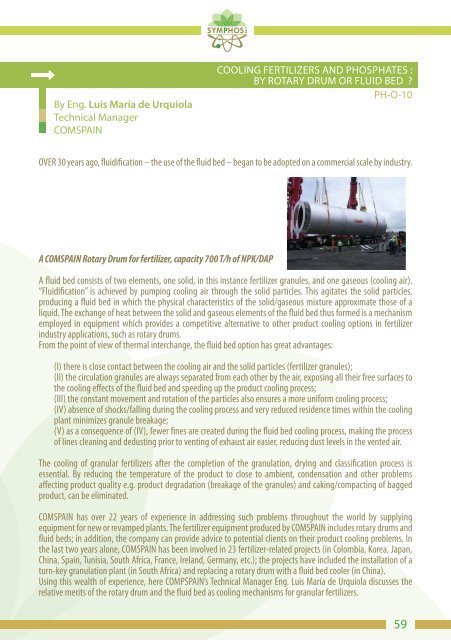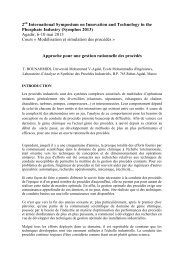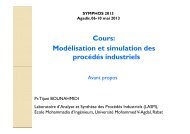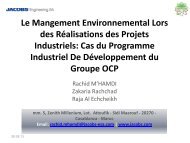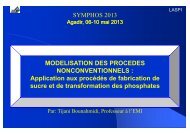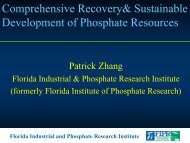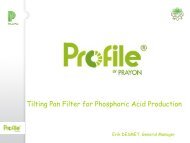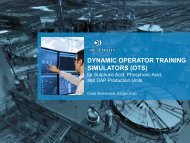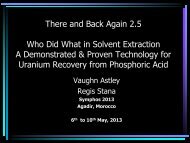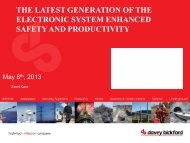Abstract SYMPHOS 2011
Abstract SYMPHOS 2011
Abstract SYMPHOS 2011
Create successful ePaper yourself
Turn your PDF publications into a flip-book with our unique Google optimized e-Paper software.
By Eng. Luis María de Urquiola<br />
Technical Manager<br />
COMSPAIN<br />
COOLING FERTILIZERS AND PHOSPHATES :<br />
BY ROTARY DRUM OR FLUID BED ?<br />
PH-O-10<br />
OVER 30 years ago, fluidification – the use of the fluid bed – began to be adopted on a commercial scale by industry.<br />
A COMSPAIN Rotary Drum for fertilizer, capacity 700 T/h of NPK/DAP<br />
A fluid bed consists of two elements, one solid, in this instance fertilizer granules, and one gaseous (cooling air).<br />
“Fluidification” is achieved by pumping cooling air through the solid particles. This agitates the solid particles,<br />
producing a fluid bed in which the physical characteristics of the solid/gaseous mixture approximate those of a<br />
liquid. The exchange of heat between the solid and gaseous elements of the fluid bed thus formed is a mechanism<br />
employed in equipment which provides a competitive alternative to other product cooling options in fertilizer<br />
industry applications, such as rotary drums.<br />
From the point of view of thermal interchange, the fluid bed option has great advantages:<br />
(I) there is close contact between the cooling air and the solid particles (fertilizer granules);<br />
(II) the circulation granules are always separated from each other by the air, exposing all their free surfaces to<br />
the cooling effects of the fluid bed and speeding up the product cooling process;<br />
(III) the constant movement and rotation of the particles also ensures a more uniform cooling process;<br />
(IV) absence of shocks/falling during the cooling process and very reduced residence times within the cooling<br />
plant minimizes granule breakage;<br />
(V) as a consequence of (IV), fewer fines are created during the fluid bed cooling process, making the process<br />
of lines cleaning and dedusting prior to venting of exhaust air easier, reducing dust levels in the vented air.<br />
The cooling of granular fertilizers after the completion of the granulation, drying and classification process is<br />
essential. By reducing the temperature of the product to close to ambient, condensation and other problems<br />
affecting product quality e.g. product degradation (breakage of the granules) and caking/compacting of bagged<br />
product, can be eliminated.<br />
COMSPAIN has over 22 years of experience in addressing such problems throughout the world by supplying<br />
equipment for new or revamped plants. The fertilizer equipment produced by COMSPAIN includes rotary drums and<br />
fluid beds; in addition, the company can provide advice to potential clients on their product cooling problems. In<br />
the last two years alone, COMSPAIN has been involved in 23 fertilizer-related projects (in Colombia, Korea, Japan,<br />
China, Spain, Tunisia, South Africa, France, Ireland, Germany, etc.); the projects have included the installation of a<br />
turn-key granulation plant (in South Africa) and replacing a rotary drum with a fluid bed cooler (in China).<br />
Using this wealth of experience, here COMPSPAIN’s Technical Manager Eng. Luis María de Urquiola discusses the<br />
relative merits of the rotary drum and the fluid bed as cooling mechanisms for granular fertilizers.<br />
59


